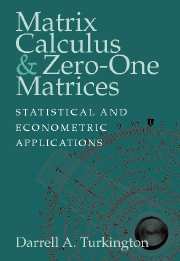5 - Linear-Regression Models
Published online by Cambridge University Press: 14 September 2009
Summary
INTRODUCTION
The linear-regression model is without doubt the best-known statistical model in both the material sciences and the social sciences. Because it is so well known, it provides us with a good starting place for the introduction of classical statistical procedures. Moreover, it furnishes an easy first application of matrix calculus that assuredly becomes more complicated in future models, and its inclusion ensures completeness in our sequence of statistical models.
The linear-regression model is modified in one way only to provide our basic model. Lagged values of the dependent variable will be allowed to appear on the right-hand side of the regression equation.
Far more worthy candidates of the mathematical tools presented in the preceding chapters are variations of the basic model that we achieve by allowing the disturbances to be correlated, forming either an autoregressive system or a moving-average system. These modifications greatly increase the complexity of the model. Lagged values of the dependent variable appearing among the independent variables when coupled with correlated disturbances make the asymptotic theory associated with the application of classical statistical procedures far more difficult. The same combination also makes the differentiation required in this application more difficult.
Our work then with these two variations of the basic linear-regression model require applications of the results and concepts discussed in the first four chapters. Particularly useful in this context will be the properties of shifting matrices and generalized vec operators discussed in Sections 3.7 and 2.4, respectively.
- Type
- Chapter
- Information
- Matrix Calculus and Zero-One MatricesStatistical and Econometric Applications, pp. 87 - 109Publisher: Cambridge University PressPrint publication year: 2001



